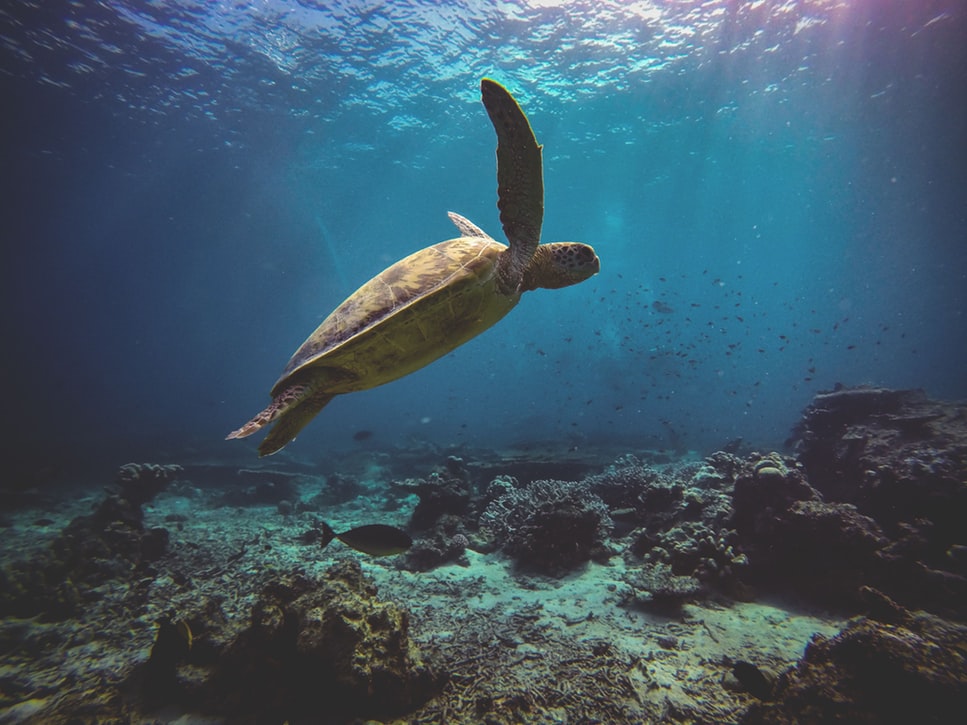Malaysian Borneo
The best dive sites in east Malaysia’s Sabah province are found among the white sand and coconut tree fringed islands of Sipadan, Mabul, Layang Layang, Lankayan, and Kapalai. Numerous dive operations like Borneo Divers, and a collection of excellent dive resorts such as Mabul Resort, make it very easy to explore this handful of islands right off the mainland. Superb coral aside, the region is renowned for its huge schools of pelagic fish, manta rays, turtles and hammerhead sharks in the hundreds, as well as for the chance to experience muck diving.
Macro photographers in particular will thrill to the treasure hunting opportunities afforded by scouring the sediment right offshore from islands like Mabul and Kapalai. Never knowing whether your next surprise discovery will come in the form of a nudibranch, pygmy seahorse, or baby lionfish makes muck diving in one of the best locations in the world a worthwhile destination in itself. Pristine Layang Layang may be the best place to surround yourself with hordes of hammerheads, but the rubbly site below the former oil rig known as the Seaventures Platform in Mabul is a fascinating location for muck and macro divers alike. For everything in between, there’s Sipadan.
Sipadan Splendours
With Sipadan now a fully protected conservation zone, you can expect to see plenty of everything. Considered by many to be one of the big fish capitals of the world, the clear waters off this island practically guarantee encounters with algae-munching turtles, swirling storms of barracuda, and enormous schools of trevally and bumphead parrotfish, at such aptly-named sites as Barracuda Point and Turtle Cavern.
Daytime or night exploration of the nooks & crannies and wide variety of sponges at The Drop Off’s wall will find you in good company with hundreds of jacks and parrotfish, as well as local reef sharks. Hanging Gardens is a spectacularly scenic wall and drop-off just a meter from the water’s surface, with terraces that descend gradually to a ledge at 70 meters (230 feet) then disappear into darkness. The wall here features gorgonian fans and soft, pastel-coloured corals galore, and stunning aquatic treasures like ribbontail stingrays, sweetlips, moray eels, and emperor angelfish, are not to be missed. Or you may simply choose to let the current take you through the shallows at Turtle Patch, while the wonders of this site’s terraces unfold before you. Staghorn corals, giant turtles, mappa puffers and lionfish all make the reef here their home, and if you’re lucky, you may even spot the illusive leaffish hanging in the current.
Welcome To Malaysia
It’s possible to enjoy scuba diving in Malaysia all year, but location is monsoon season-dependent. Rainy monsoon weather in the west is complemented by the dry season in the east, and vice versa, meaning east Malaysia’s diving season extends from April through October, while diving in west Malaysia is best from mid-November through mid-April. Dry seasons also offer the best water visibility, reaching as high as 60 meters (200 feet), while water temperatures hover at a very comfortable 27-30oC (80-86oF) all year. Malaysia is easy to reach through its international airport in the capital of Kuala Lumpur in west Malaysia, and from there, regular connecting flights will bring you to Sabah in the east.
Although English is widely used among the country’s 30 million Malay-speaking citizens, you’ll need to change your dollars for the local Malaysian Ringgit. Consider it money well spent since Malaysian Borneo is widely known for the adventure it has on offer in terms of its abundance of eco-treasures. Divers and non-divers alike can meet the Orangutan, the “wild man of Borneo”, in the largest sanctuary of its kind in the world, hike to the peak of the highest mountain in the region (Mount Kinabalu), or explore the Kinabantangan River by boat, and watch the local probiscus monkeys swinging playfully through the trees.




